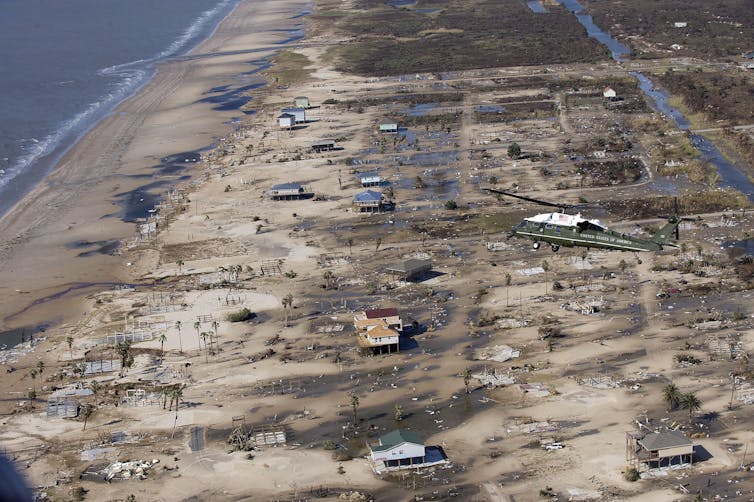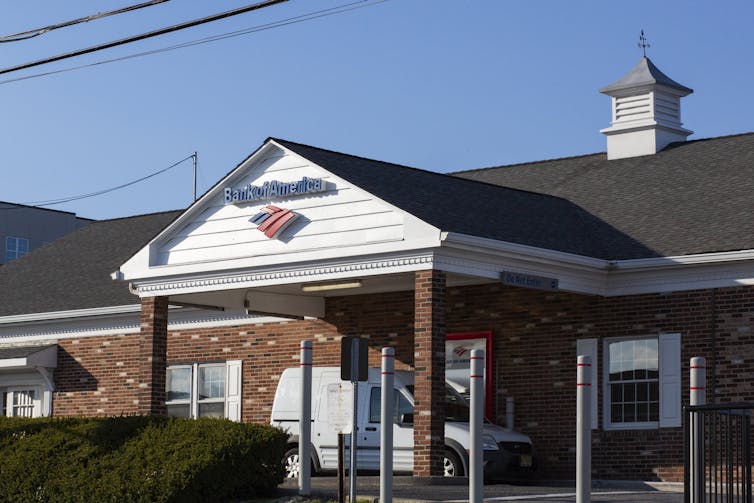Coronavirus: Why is it so hard to aid small businesses hurt by a disaster?
- Written by Maria K. Watson, Research Assistant Professor in Urban Planning, Texas A&M University
The U.S. government has committed hundreds of billions of dollars[1] to help small businesses weather the coronavirus pandemic. But early reports suggest larger companies are gobbling up much of the aid, while many of the neediest ones – particularly those with only a few dozen employees – aren’t benefiting[2].
For example, large, generally profitable companies like Shake Shack[3], Potbelly[4] and even the Los Angeles Lakers[5], with access to other lines of credit, have received millions of dollars in loans, even as mom-and-pop stores[6] across the U.S. say they are still waiting to hear back[7] about their applications.
Very small businesses, particularly those operating on small profit margins, are especially vulnerable, since they may not have the cash reserves to weather periods of economic uncertainty and typically have fewer ways to access financing. A recent poll by the U.S. Chamber of Commerce found that one in four U.S. businesses[8] is two months away from permanently shutting down.
My research on efforts to help businesses recover[9] from hurricanes and other disasters shows why smaller organizations have long struggled to get aid[10] after a crisis.
Obstacles to aid
Hurricane Ike, at the time of its impact in 2008, was the third-costliest[11] storm in the nation’s history.
It caused approximately US$30 billion[12] in damages and devastated thousands of businesses in southeastern Texas. My colleagues and I focused our study in Galveston County, Texas, where Ike made its initial landfall and more than 3,800 businesses were interrupted and 53,000 employees were put out of work[13].
The Small Business Administration[14] has a designated disaster relief program[15] intended to help small companies recover through low-interest loans. Despite the devastation, we found that most small businesses in Galveston that applied for federal assistance were unable to get aid. In fact, the approval rate for low-interest disaster loans was only around 22%[16].
The trouble is, even though this is intended as aid, it’s still a loan – and the SBA needs to make sure borrowers will pay it back. One of the main ways any lender determines whether a borrower will do so is through its credit history, which many very small businesses lack[17].
As you might expect, we found that the most common reasons the SBA denied loans were unsatisfactory credit and lack of repayment ability.
Older businesses, corporations and companies with more employees received the highest loan amounts after Hurricane Ike, even when controlling for damage. These types of companies were already in a much better position to survive a disaster like a hurricane – which is likely why the SBA deemed them less financially risky and worthy of a disaster loan.
Getting those loans made a big difference in survival rates. My research[18] found that companies that secured an SBA loan were significantly more likely to be around nine years later.
 Then-President George W. Bush inspected a damaged residential area near Galveston, Texas, after Hurricane Ike hit in 2008.
Jim Watson/AFP via Getty Images)
Then-President George W. Bush inspected a damaged residential area near Galveston, Texas, after Hurricane Ike hit in 2008.
Jim Watson/AFP via Getty Images)
Paperwork and fuzzy guidelines
But the approval rate tells only a part of the story, since it doesn’t capture businesses who never made it through the application process.
Many businesses in Galveston described applying for federal funds as “difficult” and “cumbersome,” leading many to simply withdraw their applications.
This is again where larger businesses have an advantage because they are more likely to have the necessary documents digitized – vital when a disaster destroyed the physical copies. They also have specialized staff that are familiar with financial paperwork and know how to navigate the loan process without having to take away from the day-to-day operational needs of the business. This also helps them capitalize on fuzzy guidelines[19] about who is eligible.
A report to Congress[20] from the House Committee on Small Business suggests that some businesses actually refused loans after they had been approved due to lengthy delays. As one Galveston business owner told us, “by the time you get the money your small business may be broke.” Average wait times for Hurricane Ike were 11 months after landfall.
The city of Galveston offered local companies a bridge loan[21] intended to tide them over until the disaster loan came through, but my interviews indicated that though helpful, this mostly benefited businesses with an existing relationship with affiliated banks.
 Big banks like Bank of America are handling most of the small business loans.
Kena Betancur/ VIEWpress via Getty Images
Big banks like Bank of America are handling most of the small business loans.
Kena Betancur/ VIEWpress via Getty Images
Similar themes in coronavirus aid
To combat the economic impact of the coronavirus, in late March Congress passed the $349 billion Paycheck Protection Program[22] in addition to replenishing the coffers of the SBA’s disaster loan fund.
The idea with the new program is that small businesses, especially those that have had to close during the crisis, can get very low-interest loans that turn into grants as long as they meet certain conditions, like not laying off staff.
After the money was drained in two weeks – and reports surfaced of larger companies getting some of the aid – Congress topped it off with $310 billion[23] and tightened its restrictions on which businesses can use it.
But so far, smaller companies seem to be encountering the same problems I uncovered following Hurricane Ike.
For example, businesses are still finding it difficult to apply[24] for assistance. Unclear guidelines led to confusion in how the process would be rolled out and executed, even in the second round[25].
Like after Hurricane Ike, businesses with existing relationships with banks[26], such as having open lines of credit, seem to be benefiting. The assistance is grounded in a loan program[27], which favors larger businesses. This has the potential to be exacerbated by the high competition for funds and the need for businesses to apply quickly.
And although COVID-19 assistance is different from previous disasters in that the loans are potentially forgivable, they are still loans[28] that – if not turned into grants – must be paid back and could compound the issues businesses are already facing from a likely sharp drop in revenue.
The Treasury Department’s vow to audit who took out loans to ensure recipients adhere to the rules will help, as will Congress’ decision to direct 10% of the new funds[29] to community banks. Local lenders have been quicker to lend[30] and motivated to help their communities[31].
Unfortunately, if history is any guide, it may not be enough to ensure these small businesses are getting the help they desperately need.
The Conversation has received funds from the Paycheck Protection Program.
[You need to understand the coronavirus pandemic, and we can help. Read The Conversation’s newsletter[32].]
References
- ^ has committed hundreds of billions of dollars (www.washingtonpost.com)
- ^ aren’t benefiting (www.wsj.com)
- ^ Shake Shack (www.cnbc.com)
- ^ Potbelly (www.cnbc.com)
- ^ Los Angeles Lakers (www.washingtonpost.com)
- ^ mom-and-pop stores (www.theguardian.com)
- ^ waiting to hear back (www.npr.org)
- ^ one in four U.S. businesses (www.uschamber.com)
- ^ efforts to help businesses recover (doi.org)
- ^ have long struggled to get aid (oaktrust.library.tamu.edu)
- ^ third-costliest (www.hcfcd.org)
- ^ US$30 billion (www.nhc.noaa.gov)
- ^ 3,800 businesses were interrupted and 53,000 employees were put out of work (www.fema.gov)
- ^ Small Business Administration (theconversation.com)
- ^ designated disaster relief program (www.sba.gov)
- ^ was only around 22% (velazquez.house.gov)
- ^ small businesses lack (www.federalreserve.gov)
- ^ My research (oaktrust.library.tamu.edu)
- ^ capitalize on fuzzy guidelines (www.cnn.com)
- ^ A report to Congress (velazquez.house.gov)
- ^ bridge loan (www.galvestontx.gov)
- ^ $349 billion Paycheck Protection Program (www.sba.gov)
- ^ topped it off with $310 billion (www.cnbc.com)
- ^ it difficult to apply (www.nytimes.com)
- ^ even in the second round (www.politico.com)
- ^ existing relationships with banks (www.businessinsider.com)
- ^ is grounded in a loan program (www.cbsnews.com)
- ^ they are still loans (www.cbsnews.com)
- ^ direct 10% of the new funds (thehill.com)
- ^ quicker to lend (www.nytimes.com)
- ^ motivated to help their communities (www.latimes.com)
- ^ Read The Conversation’s newsletter (theconversation.com)
Authors: Maria K. Watson, Research Assistant Professor in Urban Planning, Texas A&M University


